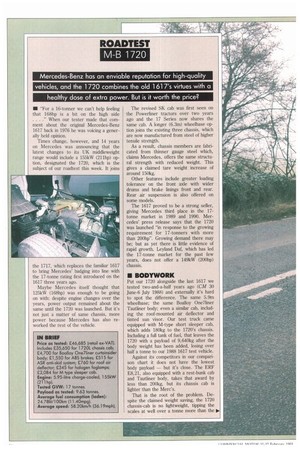ROADTEST
Page 40

If you've noticed an error in this article please click here to report it so we can fix it.
M-B 1720
IN "For a 16-tonner we can't help feeling that 168hp is a bit on the high side . . ." When our tester made that comment about the original Mercedes-Benz 1617 back in 1976 he was voicing a generally held opinion.
Times change, however, and 14 years on Mercedes was announcing that the latest changes to its UK middleweight range would include a 155kW (211hp) option, designated the 1720, which is the subject of our roadtest this week. It joins the 1717, which replaces the familiar 1617 to bring Mercedes' badging into line with the 17-tonne rating first introduced on the 1617 three years ago.
Maybe Mercedes itself thought that 125kW (168hp) was enough to be going on with: despite engine changes over the years, power output remained about the same until the 1720 was launched. But it's not just a matter of same chassis, more power because Mercedes has also reworked the rest of the vehicle.
The revised SK cab was first seen on -the Powerliner tractors over two years ago and the 17 Series now shares the same cab. A longer (6.3m) wheelbase option joins the existing three chassis, which are now manufactured from steel of higher tensile strength.
As a result, chassis members are fabricated from thinner gauge steel which, claims Mercedes, offers the same structural strength with reduced weight. This gives a claimed tare weight increase of around 150kg.
Other features include greater loading tolerance on the front axle with wider drums and brake linings front and rear. Rear air suspension is also offered on some models.
The 1617 proved to be a strong seller, giving Mercedes third place in the 17tonne market in 1989 and 1990. Mercedes' press release says that the 1720 was launched "in response to the growing requirement for 17-tonners with more than 200hp". Growing demand there may be; but as yet there is little evidence of rapid growth. Leyland Daf, which has led the 17-tonne market for the past few years, does not offer a 149kW (200hp) chassis.
Put our 1720 alongside the last 1617 we tested two-and-a-half years ago (CM 30 June-6 July 1988) and externally it's hard to spot the difference. The same 5.9m wheelbase; the same Boalloy One7liner Tautliner body; even a similar cab, including the roof-mounted air deflector and tinted sun visor. Our test truck came equipped with M-type short sleeper cab, which adds 180kg to the 1720's chassis. Including a full tank of fuel, that leaves the 1720 with a payload of 9,640kg after the body weight has been added, losing over half a tonne to our 1988 1617 test vehicle.
Against its competitors in our comparison chart it does not have the lowest body payload — but it's close. The ERF E8,21, also equipped with a rest-bunk cab and Tautliner body, takes that award by less than 200kg, but its chassis cab is lighter than the Merc's.
That is the root of the problem. Despite the claimed weight saving, the 1720 chassis-cab is no lightweight, tipping the scales at well over a tonne more than the
















































































